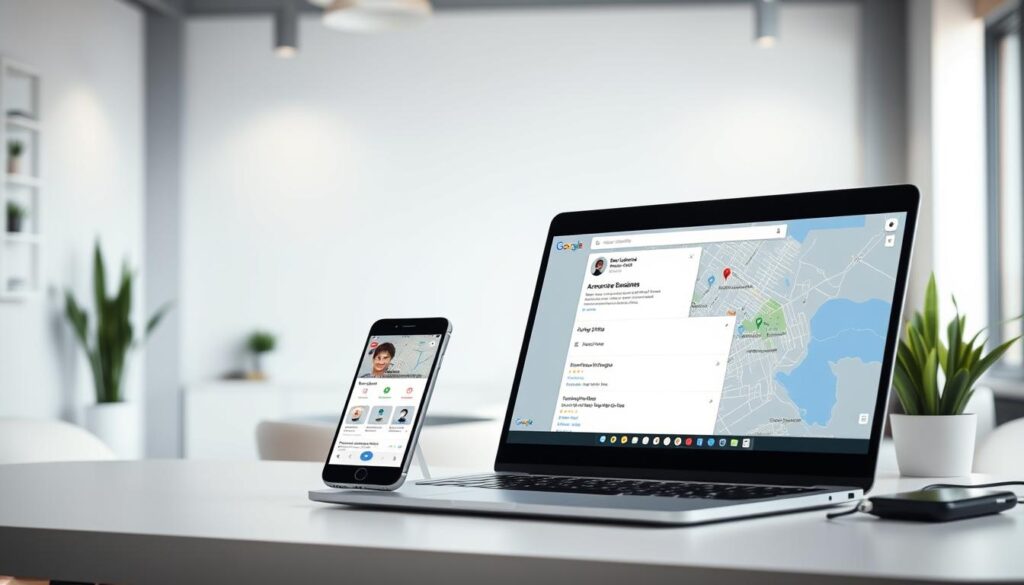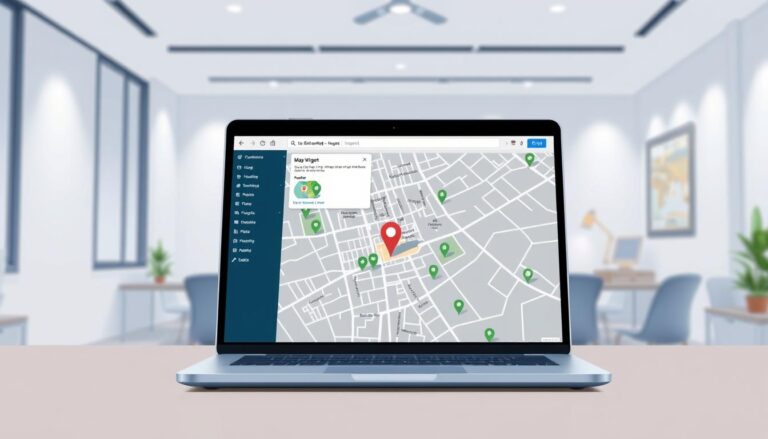As a business owner, knowing about local search optimization is key today. Most people use online searches to find what they need nearby. A good local SEO strategy can make your business more visible and bring in more customers.
I’ve seen how focusing on local SEO can make a big difference. By making your website and online presence better for local searches, you can stand out. This attracts more people to your business.
Key Takeaways
- Understand the importance of local SEO for your business.
- Learn how to optimize your website for local search.
- Discover strategies to improve your local search visibility.
- Find out how to dominate your local market with effective SEO tactics.
- Improve your online presence to attract more local customers.
Understanding the Local SEO Landscape
Local SEO is more than just a trend; it’s key for business growth. It’s complex, but understanding it is vital.
Why Local SEO Is Critical for Business Growth
Local SEO helps businesses attract local customers. It boosts visibility and drives more foot traffic. This can lead to higher sales.
In fact, nearly 76% of people who search for something nearby on their smartphone visit a related business within a day. This shows how important local SEO is for growth.
The Difference Between Local and Traditional SEO
Traditional SEO focuses on broad keywords. Local SEO targets location-specific searches. For example, a coffee shop might optimize for “coffee shops in New York City.”
This approach can greatly improve a business’s online visibility.
Key Local Ranking Factors in 2023
So, what affects local search rankings? It’s a mix of proximity, relevance, and prominence.
Proximity Factors
Proximity factors look at how close a business is to the searcher. This includes distance and physical presence.
Relevance Signals
Relevance signals show how well a business matches the search. This includes category, keywords, and content quality.
Prominence Indicators
Prominence indicators reflect a business’s reputation. This includes online reviews, ratings, and local mentions.
Optimizing Your Google Business Profile for Maximum Visibility
To dominate your local market, it’s key to boost your Google Business Profile visibility. A well-optimized profile can greatly improve your online presence. This drives more customers to your business.
Complete Profile Setup and Verification Process
Setting up and verifying your Google Business Profile is the first step. I make sure my business info is correct and current. This includes my business name, address, and phone number.
Verification is key. It shows Google my business is real and at the right address.
Strategic Category Selection and Attribute Optimization
Choosing the right categories and attributes is vital. I pick categories that match my business well. This makes it easier for customers to find me.
Attributes like “wheelchair accessible” or “free Wi-Fi” add context. They make my profile more visible and appealing.
Leveraging Photos, Posts, and Q&A Features
To optimize my Google Business Profile, I use photos, posts, and Q&A. High-quality photos show off my business’s offerings. Engaging posts keep customers updated on news and deals.
Image Optimization Best Practices
I optimize my images by:
- Using high-resolution and well-lit photos
- Choosing photos that match my business
- Captioning photos with relevant keywords
Creating Engaging Google Posts
To make engaging Google Posts, I focus on:
- Announcing special offers or events
- Sharing updates about my business
- Encouraging customer interaction
Managing Customer Questions Effectively
I answer customer questions quickly and accurately. This improves customer satisfaction and my business’s credibility.

Local SEO Strategy: Keyword Research and On-Page Optimization
To dominate your local market, a well-planned local SEO strategy is key. It starts with thorough keyword research and on-page optimization. These steps make your business more visible to local customers online.
Identifying High-Intent Local Search Terms
Knowing what your customers are searching for is essential. High-intent local search terms show they want to buy or use a service in your area.
Using Keyword Research Tools for Local Insights
Keyword research tools offer valuable local search insights. Tools like Google Keyword Planner, Ahrefs, or SEMrush show relevant local keywords, their search volume, and competition.
Analyzing Competitor Local Keywords
Looking at your competitors’ websites can reveal opportunities. It’s about finding the keywords they rank for and how to beat them.
Optimizing Website Elements for Local Search
After finding your target local keywords, optimize your website. This includes several on-page optimization techniques.
Title Tags and Meta Descriptions
Your title tags and meta descriptions should include your target local keywords. This helps search engines see your page’s relevance to local searches.
Header Tags and Content Structure
Using header tags (H1, H2, H3, etc.) makes your content easier to read. It also highlights important keywords. Your content should naturally include local keywords.
Creating Location-Specific Content That Converts
Creating location-specific content is vital for attracting local customers. It should meet the needs and interests of your local audience, boosting conversion chances.
By focusing on these local SEO aspects, businesses can boost their online presence. They can attract more local customers and drive more sales.
Building a Strong Citation and Backlink Profile
A strong citation and backlink profile is key for any local SEO success. It boosts your online presence and credibility with search engines. This makes it easier for customers to find you.
Ensuring NAP Consistency Across the Web
Keeping your business’s Name, Address, and Phone Number (NAP) consistent online is vital. Inconsistent NAP can confuse search engines and hurt your local search rankings. To fix this, do a thorough audit of your online listings and correct any errors.
Steps to Ensure NAP Consistency:
- Find all online directories and listings where your business is listed.
- Make sure your NAP is the same on all listings.
- Keep an eye on your listings for any changes or errors.
Top Local Directories and Listing Opportunities
Listing your business in the right directories can greatly improve your local SEO. Here are some top directories and listing opportunities to consider:
Industry-Specific Directories
Listing in industry-specific directories can help you stand out among relevant businesses. For instance, a law firm might list itself on Avvo or Martindale-Hubbell.
Local Chamber and Business Association Listings
Joining your local chamber of commerce or business association offers networking chances. It also gets your business listed in their directories, boosting your local online presence.

Earning Quality Local Backlinks Through Community Engagement
Getting quality backlinks from local sources can greatly improve your local search rankings. Engage in your community by sponsoring events, partnering with local businesses, or helping with charity work. This earns you backlinks from reputable local sources.
Benefits of Community Engagement:
- Increases your business’s local visibility.
- Builds relationships with other local businesses and organizations.
- Provides opportunities for quality backlinks from local sources.
Managing Your Online Reputation and Reviews
Online reputation management is key for local SEO. Your online image can sway customer choices. So, managing reviews and feedback well is vital.
Implementing a Systematic Review Generation Process
To keep a good online image, you need a clear plan for reviews. This means:
- Identifying happy customers and asking for their thoughts
- Making it simple for them to leave reviews by giving direct links
- Checking in with customers to make sure their online experience matches their real one
Crafting Thoughtful Responses to Customer Feedback
It’s important to reply to customer reviews. It shows you value their opinions and care about their experiences.
Handling Positive Reviews
For positive reviews, say thank you and show you’re glad they’re happy. For example, “Thank you for your kind words, we’re glad you enjoyed our service.”
Addressing Negative Reviews Professionally
For negative reviews, stay calm and professional. Acknowledge the problem, apologize if needed, and offer a fix. For instance, “We apologize for the trouble. Please contact us so we can fix it.”
Tools for Monitoring Your Local Brand Reputation
Use tools like Google Alerts, Hootsuite, or Mention to watch your online presence. These tools help you keep up with reviews and feedback. This way, you can respond quickly and keep your online image positive.
By using these strategies, you can manage your online reputation well. This will boost your local SEO efforts.
Measuring Success and Scaling Your Local Dominance
To see if local SEO is working, it’s key to watch certain numbers. I look at website visits, how well we rank for local keywords, and the number of online reviews. These show if our local search plans are hitting the mark.
Checking these numbers helps me see if our local SEO is doing well. I use tools like Google Analytics and Google Search Console to keep an eye on things. This way, I can spot what needs work and tweak our plans.
To grow our local lead, we build on what we’ve already done. This means adding more keywords, making our website better for users, and getting more involved in social media and local events. By always improving and changing our local SEO, we can get stronger in our local market.
Local SEO is a never-ending job that needs constant checking and fine-tuning. Keeping up with new trends and tips helps me make sure our local SEO stays sharp and relevant. This way, we can keep up with the changing world of search.










